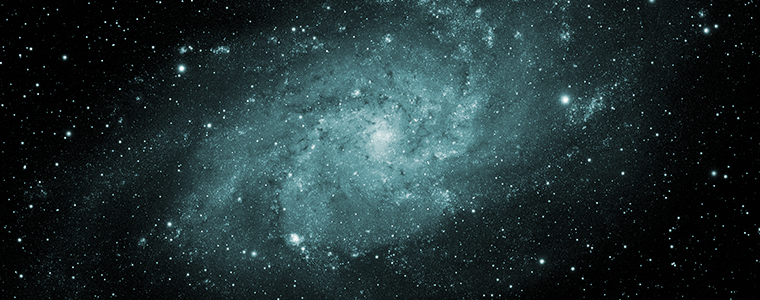Cosmic Visions: Bridging Science and Art
Charles W. Henebry & Millard Baublitz, Boston University, College of General Studies
Since the dawn of recorded history, stargazing has shaped—and been shaped by—our understanding of the universe and the place of humans within it. Though we tend to conceptualize art and science as separate spheres, the observation of the heavens has always been interwoven with culture, and artists and astronomers continue to draw inspiration from one another even today. The authors of this paper, over the past few years, have developed and team-taught an interdisciplinary course titled Cosmic Visions: The Science of Astronomy and the Arts. Our course traces the shared, often symbiotic, history of these two ways of knowing, combining scientific instruction with examination of art in a range of genres and traditions, including visual art, music, and theater. Each week students engage in discussions, listen to lectures, and consider readings related to both the science of astronomy and the role of celestial objects in literature and the arts. A midterm and a final exam test students’ mastery of the science, while short essays on works of art and literature challenge them to think about how our changing understanding of heavenly bodies intersects with changing beliefs about humanity. The course culminates in an art project in which students express their own vision of the cosmos and our place within it.
What happens when students employ humanistic modes of analysis in company with scientific ones? How does artistic expression change students’ apprehension of scientific concepts? This short essay offers preliminary answers to these deep pedagogical questions.
I. Student Population
We developed Cosmic Visions in response to changes in Boston University’s general education requirements. Whereas the preceding system allowed individual colleges to set their own general education distribution requirements for their students, the 2018 BU Hub for the first time applied a single framework for undergraduate general education across the university. As faculty at BU’s College of General Studies, we saw an opportunity for creating a science course that would appeal to students at the university’s College of Fine Arts (CFA). Working in consultation with CFA division heads, we crafted a course of study that would check off a Writing Intensive Hub requirement as well as Scientific Inquiry I.
In our first year of operation, the course was dominated by students from CFA’s theater program, many of whom transferred in during the first weeks of the semester, as word-of-mouth circulated within that tight-knit group. They were a lively group to teach, full of questions and ideas, but also full of anxiety about basic mathematical concepts like ratios—not to mention concern about mastering scientific content in preparation for exams. At the end of the semester, they premiered some truly amazing artworks, ranging from movement pieces to costume designs.
The student population shifted markedly in our second year of operation, with a significant contingent of STEM students from the College of Arts and Sciences (CAS) signing up. While unsurprising in retrospect, it had not occurred to us that our arts-friendly science course might also appeal to STEM students looking for a science-friendly writing-intensive course. Direct comparison of the two groups is hindered, however, by a fundamental difference in class structure: in an effort to allow all students to attend in-person during the 2020 pandemic, we moved Professor Baublitz’s astronomy lectures online and divided classroom time into discussion sections covering the astronomy homework, the experimental fieldwork, and the assigned art and literature. In this discussion-heavy class structure, the new population proved not only more willing to engage with simple mathematical relationships, but also more eager to think about the interrelationship of astronomy with religion and the arts. But both groups benefitted, we believe, from our historical approach to teaching the science of astronomy.
II. The History of an Ancient Science
Science can be described as a system of knowledge or way of knowing that relies on (1) observations of phenomena and (2) the formulation of theories or models to explain the observations and perhaps predict future observations. Thus, it is fitting that the first weeks of the course emphasize observations of the sun, moon, planets, and stars made by ancients, and similar “naked eye” observations that can be replicated today except as precluded by light pollution. Our ancient ancestors observed the sun, moon, and stars far more intently than most people today because their lives depended on those observations. The ancients had to observe the sun and moon to know when to plant or harvest crops, to keep track of seasons and create calendars, and for navigation at sea. Ancient inscriptions describing astronomical phenomena remain today, fascinating archaeologists and astronomers alike. Some ancient cultures constructed megalithic stone structures, like Stonehenge in England and Chichén Itzá in Mexico, to observe the solstices, equinoxes, and other astronomical events.
To illustrate the apparent motions of the sun and moon, we turned the darkened classroom into a low-budget planetarium using only a flashlight and signs marking the four cardinal directions: North, South, East, and West. We demonstrated the diurnal apparent motion of the sun and the variation of the sun’s altitude as a function of season and the observer’s latitude on Earth.
In an effort to expose students to the rudiments of the scientific method, we created a series of astronomical fieldwork assignments. Introduced late in course development, these were considerably expanded and systematized in our second year. A typical experiment involved asking students to observe and measure the autumnal equinox, one of two days when the sun rises precisely in the East and sets precisely in the West. For this assignment, students photographed the setting sun on September 22, 2020, weather permitting, diagrammed their observations on a map, and then explained any apparent deviation of sunset from due West.
Figure 1 shows a student’s experimental results for the time and location of sunset on the autumnal equinox, as observed from a bridge over the Massachusetts Turnpike close to Kenmore Square in Boston. The student estimated the final position of the sun by extrapolating from observations of its position prior to sunset. Her results show a slight experimental error, 4.5° south of true west.
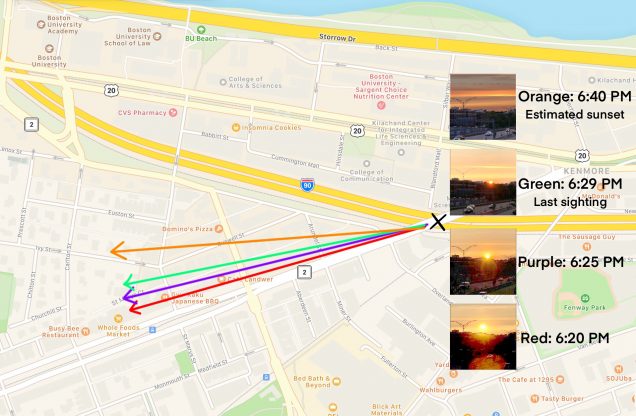
The earliest civilizations also took special note of the moon and five “wandering stars” or planets in the sky, which seemed to roam over the course of months from one constellation of stars to another. We sought to bring this to life for our students by scheduling the class for an evening time slot, allowing us to take our students outside on clear evenings to observe any planets visible in the sky and to distinguish them from the “fixed stars” of the constellations. The results were particularly spectacular in fall 2020, when we observed on several consecutive Monday evenings the approaching conjunction of Jupiter and Saturn, as well as Mars in retrogression, shining brightly red in the east.
Although observation is an essential component of the scientific endeavor, without the construction of models or theories even systematic observation of natural phenomena can yield only an inchoate, incomplete form of science. In an effort to spotlight the messy process of scientific progress, we organize course material historically, allowing us to explore both incremental changes in scientific understanding and revolutionary shifts. In total, we examine three distinct epistemes in the development of astronomy, the oldest of the sciences: the earth-centered systems of ancient Mediterranean and Central American peoples, the sun-centered system developed in sixteenth- and seventeenth-centuries, and the radically uncentered, infinitely expanding universe of twentieth and twenty-first century cosmology.
The apparently irregular motions of the planets, especially the retrograde motions of the planets when they would seem to stop and then reverse direction, were especially perplexing to the early observers. Aristotle adopted an Earth-centered model of the cosmos in which each planet was associated with four or more nested geocentric spheres that rotated about different axes at different rates; in this way, he could provide a crude representation of the planets’ irregular motions. (Aristotle). About four centuries later, Ptolemy improved accuracy by proposing a more complex model, adding epicycles and shifting the stationary Earth slightly away from the cosmos’ center (Ptolemy).
In the year 1500, few people believed that Earth moved, and the Ptolemaic model of planetary motion was generally, if not universally, accepted. By 1700, few educated people doubted that the Earth orbits yearly about the sun. Students in our course make telescopic observations of the moons of Jupiter, learn of the astronomical observations of Galileo and others, study the planetary models of Copernicus and Kepler, and grapple with the paradigm shift, as a sun-centered solar system became the commonsense way to understand the cosmos by the close of the seventeenth century.
The invention of the telescope provided not only detailed images of the planets and their newly discovered moons, but this invention also allowed Galileo and others to resolve the faint band of light known as the Milky Way into a vast number of individual stars. The Sun is only a somewhat larger than average star in the Milky Way, which is a rotating disk-shaped aggregate of more than a hundred billion stars. More recently, the construction of large reflecting telescopes, which use mirrors instead of lenses, has allowed astronomers to confirm that some nebulae, which previously appeared as just hazy patches of light, are actually what Immanuel Kant had hypothesized as “island universes,” or in other words, galaxies of stars comparable in size to the Milky Way. Figure 2 is an image of the galaxy UGC 12158, which is about 380 million light-years away and resembles the Milky Way in appearance.
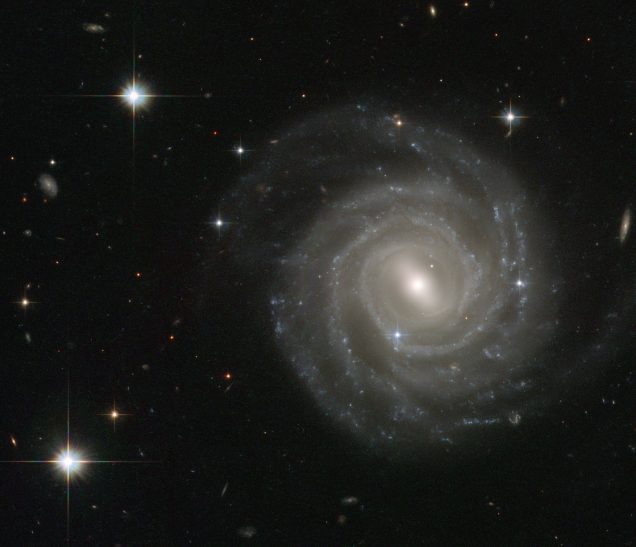
Twentieth-century measurements show that all galaxies in the universe are moving away from the Local Group of galaxies where the Milky Way is located. This expansion suggests that at an earlier time the universe must have been much smaller and denser. This is one line of reasoning that led to formulation of the Big Bang Theory, which today is the generally accepted scientific theory of the origin of the universe: all matter, energy, and even space-time itself had its origin in a singularity about 13.7 billion years ago. Earlier generations believed the Earth, or the Sun, or perhaps the center of the Milky Way was the center of the universe. By contrast, according to current ideas, the big bang “had no center, it had no past, it simply was the sudden beginning of everything in an expanding geometry” (Impey). Truly, humankind’s conception of the cosmos has changed remarkably, since our ancient ancestors gazed at the sky!
Why is this historical approach to astronomy a useful one, pedagogically speaking?
On the one hand, by taking a qualitative approach to astronomy, we help non-STEM students appreciate what makes a science a science: the scientific method. In their fieldwork experiments students get a sense of the challenges that scientists face in conducting even routine observations—and hence the difficulty of making even incremental improvements to scientific understanding. At the same time, the historical sweep of the course demonstrates how science proceeds sometimes at a crawl and sometimes in great leaps. This perspective is valuable for STEM and non-STEM students alike, as it is rarely given extended attention outside specialized courses in the history of science. In short, the millennia-old struggle of astronomers to understand the cosmos typifies the broader human pursuit of scientific understanding, a process Francis Bacon compared to the episode in the Odyssey when Menelaus wrestled with the shape-changing sea-god Proteus, clinging fast until the god was forced to show his true nature (Bacon).
III. The Cosmos and the Arts
Our historical orientation also provides scaffolding for works of art and literature. Each week in preparation for class, students write a brief response to one or more cultural artifacts roughly contemporaneous to the astronomers we are studying that week. The twentieth century proves an especially fertile era, with art ranging from sci-fi stories, radio plays, and movies to “space music” and “space art.” But earlier in the semester, we focus on cosmologies represented in Egyptian religious artifacts, Roman epic, and Renaissance love poems. These various works of art provide windows on the mindset of earlier eras, whether the stoic fatalism of Virgil, the anticolonial satire of Georges Méliès, or the otherworldly optimism of John Serrie. In so doing they invite students to draw connections between an era’s cultural and religious beliefs and the scientific understanding then prevailing. One student gave particularly eloquent expression to the connection between science and religion in an essay-length analysis of Kubrick’s 2001: A Space Odyssey entitled “Monolithism: The Religion of the Cosmos”:
As science has progressed, … the field has slowly explained away many of nature’s supernatural interpretations and sacred objects: we no longer view the planets as literal gods in the sky, but as the nearly spherical collections of gas, dust, rock, and ice that they are. We now look to the stars in search of data, not deities. However, this gradual transition has not stopped humans from exploring their origin and place in the universe through space art, music, and film. Although some may think that the modern, scientific view of cosmology downplays spiritual importance from the heavens, Stanley Kubrick’s film 2001: A Space Odyssey uses monoliths in place of more typical religious deities to show that humans still look to the cosmos for a source of inspiration and creation in an otherwise cold, unforgiving universe. (Gjonbalaj)
In this opening to his essay, Nik Gjonbalaj offers an insightful explanation for Kubrick’s strange coupling of cold empiricism with cosmic wonder, showing how that film participates in an age-old tendency for humans to look to the stars in search of answers.
Several students testify in course evaluations to the value of coupling astronomy with historical analysis of the arts. One notes, “The arts portion of the course was really interesting. I can see how the cosmos has affected human perspective and how it continues to influence to this day. When outside the classroom, I can see influences the cosmos has on artwork I see every day.” Another student comments: “This course effectively ties the arts with the science of astronomy.” Still another enthuses, “This is exactly the type of class BU should encourage.… I love astronomy, but never would have been able to fit an astronomy class in with all the classes I need to take to graduate.” More than a few students indicated that weekly assignments and feedback helped improve their writing skills.
But our course adds a further dimension to its interdisciplinarity, asking students to plan and execute an end-of-semester art project that, like the historical artworks we examine, in some way gives expression to the cosmos and/or our changing conceptions of humanity’s place within it. Over the past two years, projects have ranged from performance pieces, to visual art, to costume or set design, to works of fiction and even comic books. Some students choose to draw on ancient myths and artifacts that we study, while others have created future-facing works of science fiction.
Unsurprisingly, this element of the course proved particularly popular in 2019, with its large contingent of students from the College of Fine Arts: “I found the artistic element of the class to be vital in my overall success…. I really appreciated this class because it provided me an opportunity to learn science but still stimulate my very artistic brain” (emphasis in original). Another gave a notably similar assessment of the course’s neurological appeal: “I learned a lot, and the engagement with humanities allowed me to stay engaged and use both parts of my brain in class.” Such comments suggest that CFA students conceptualize science and the arts in oppositional terms—and that they think of the wider university as a space generally hostile to creative expression.
These students’ excitement stands in marked contrast to the trepidation of students who do not consider themselves artists: “I have never dreaded an assignment as much as I dreaded the Final Art Project all semester,” one wrote in an evaluation from the 2020 class, before going on to report “But then it turned out to be one of my favorite assignments ever.” Here we encounter the same oppositional thinking, only from the other side of the fence, as if analysis and creativity were so distinct as to constitute different types of people.
Turning from this testimony to students’ artistic output, we find evidence that analysis and creativity actually do work hand-in-hand. In 2019, Mya Ison and Isabel Van Natta crafted and performed a movement piece, The Creation of Eden, connecting the famous centerpiece on the ceiling of the Sistine Chapel to the gravitational attraction of astronomical bodies and the erotic connection between two humans (Figure 3).

In the same year, Maia Soltis designed eight costumes for a ballet centered on myths from around the world of the “Seven Sisters”: known variously as “the Pleiades, the MaiMia, Matariki, and Subaru,” their stories are remarkably consistent: a cluster of maidens fleeing a brutish male pursuer. In all these versions, comments Soltis, “they are never caught. Often, the pursuer joins them in the sky, but is forced to forever chase the sisters and never catch up. I find this example of female empowerment extremely compelling, especially because of its universal nature.” In her artist’s statement, Soltis makes clear how both scientific knowledge and cultural analysis fed her artistic vision (Figure 4):
I wanted to explore the sisters’ female strength as well as draw upon the many cultures that inspired the piece. I wanted the sisters’ costumes to be simple and light so as to emulate the nebulae that surround the stars and contrast them with the male dancer. The goal was to create dresses that cling to the women in such a way that they look like a part of their bodies while the male dancer’s costume is heavier and obviously manmade. (Soltis)
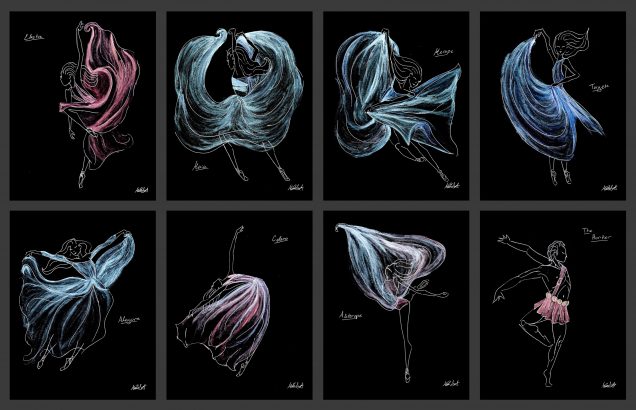
More recently, in our second year, Lauren Girouard, a CFA music student, riffed on Holst’s 1916 suite The Planets in creating A Percussive Journey through Outer Space. Her finished work shows the impact of a century’s worth of musical innovation and scientific discovery:
While The Planets depicts planetary mythology through a symphonic work, this percussive journey narrows the expression of musical ideas to the realm of percussion. In this way, the soundtrack follows the trend of contemporary music, which often takes more of a minimalistic approach in terms of instrumentation and harmonies. (Girouard)
As a work of music, Girouard’s work stands out for the priority it gives to vision over sound, taking video footage from space missions as its starting point and plotting percussive “beats” to match those visuals: “Instrumentation and textures were guided by the visual stimuli of the video, and sounds were deliberately made to evoke astronomical characteristics of celestial bodies.” In this sense, Girouard conceptualizes her artistry as responding to observation, something like the practice of scientists.
A final instance shows the capacity of STEM students to engage creatively with the course material. Nicholas Melvin, a math and computer science major from the College of Arts and Sciences, created a 13-page comic-book retelling a Cherokee myth in a science-fiction setting. The frog that ate the sun is one of a host of myths dreamed up to explain the rare and terrifying experience of a total solar eclipse. But where the Chinese imagine the sun being swallowed by a great dragon, the Cherokee cast a mere frog as the villain, giving a humorous cast to the fearful event. According to tradition, the frog can be driven away by making noise: drumming, shouting, a festive hullaballoo. Appropriately, then, Melvin’s comic has both epic scope and comedic delivery. Executed in a mixture of styles, from a professional “Photoshop” look to the deliberately childish look of Microsoft Paint, it shows mastery of the rhythms of comic-book narrative.
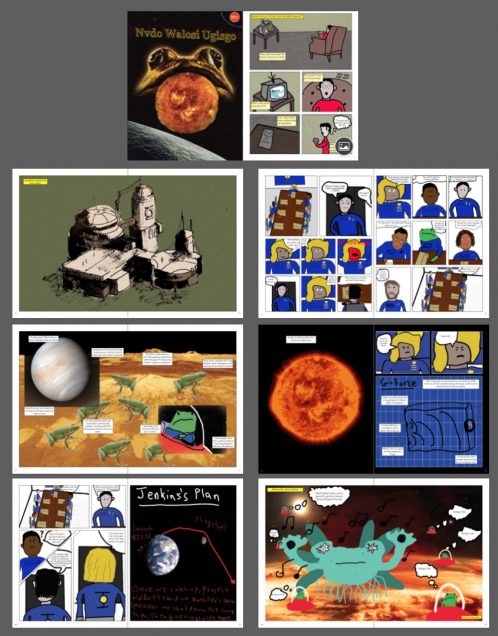
IV. Concluding Thoughts
Cosmic Visions presents a natural science, astronomy, in qualitative terms with a focus on its history and with the goal of teaching students an appreciation of the scientific method. Many students begin the course with a sense of a clear divide between the sciences and the arts, between left and right brain, between analysis and creativity. Our course instantiates that divide in its subtitle, “the science of astronomy and the arts” and in its team-taught structure, with one professor from Natural Sciences and the other from Rhetoric. At the same time, however, we challenge that divide, showing how the practice of science is often creative, and how creative expression in the arts often draws on analysis for insight.
Works Cited
Aristotle. On the Heavens. http://classics.mit.edu/Aristotle/heavens.html
Bacon, Francis. “XIII. Proteus, or Matter.” Of the Wisdom of the Ancients. 1609. https://www.bartleby.com/82/13.html
Girouard, Lauren. “Artist’s Statement.”
Impey, Chris. Astropedia. “Chapter 17: Cosmology, Section 4 – The Big Bang Model.” https://www.teachastronomy.com/textbook/Cosmology/The-Big-Bang-Model/ [Accessed April 14, 2021].
Melvin, Nicholas. “Artist’s Statement.”
Ptolemy. (1999). Ptolemy’s Almagest. Edited by: G. J. Toomer, Princeton University Press. DOI: https://doi. org/10.1515/9780691213361
Soltis, Maia. “Artist’s Statement.”
